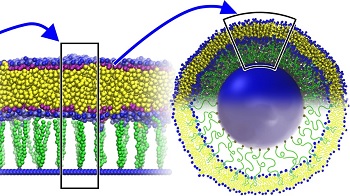 |
| Liposome stabilized by an anchoring membrane--Courtesy of CMU |
As far as nanostructures are concerned, liposomes are some of the simplest forms. Culled from the basic structure of lipids in the cell membrane, the layered surface has widely been used to protect drugs as they travel through the body. And researchers from Carnegie Mellon University may have found a theoretical model to make liposomes even more effective.
With the aid of computational modeling, the scientists designed at the molecular level a more stable liposome using a scaffolding system made of gold or iron. Like vertical steel beams supporting a building's roof, the design promises to help the liposome remain sturdy as it travels toward a target in the harsh environment of body.
When it comes to delivering dangerous cancer drugs, this support could help more of the drug reach the tumor rather than dispersing and finding their way to healthy organs.
Using three different computer models, the researchers tethered the metal "spokes" to the lower surface of the liposome using polymer connectors that could act as shock absorbers as the liposome is jostled through the body. The different models allowed them to design the system at varying scales, from the atomic level to the larger, structural components.
"Even with current forms of targeted drug delivery, treatments like chemotherapy are still very brutal. We wanted to see how we could make targeted drug delivery better," lead author Markus Deserno said in a statement. The team published its results in the journal ACS Nano.
- here's the CMU report